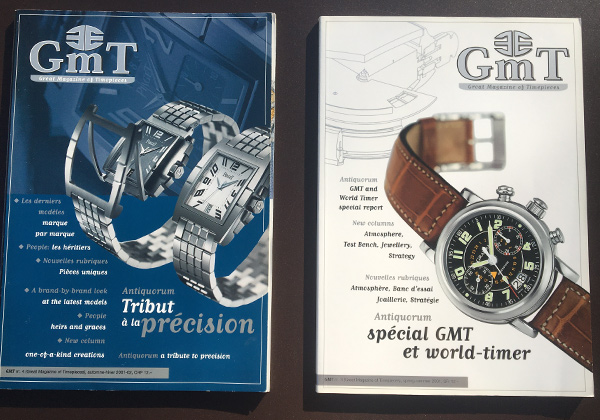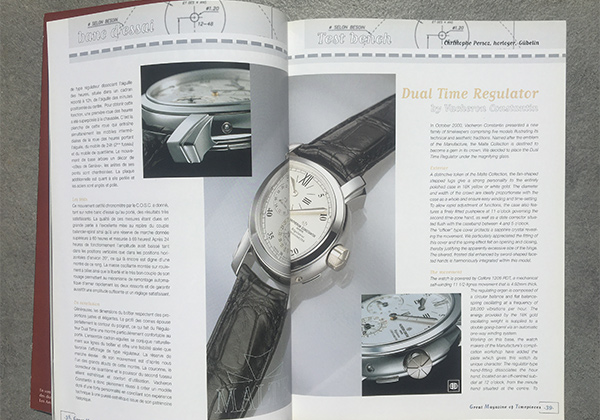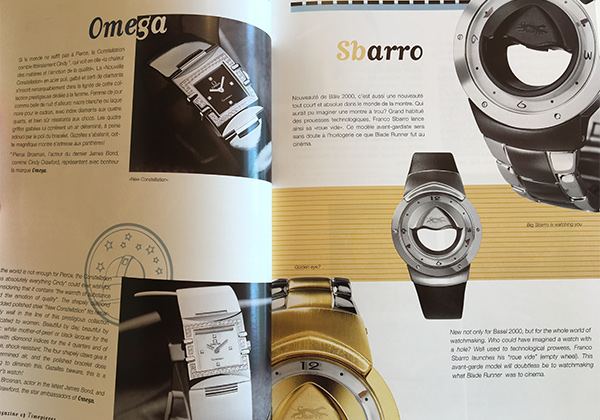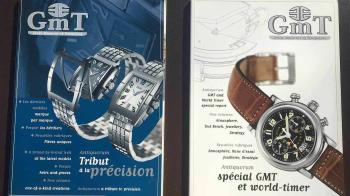In the second year of its existence, GMT echoed the accelerating world of watchmaking. This retrospective look into 2001 is by no means exhaustive and simply relates a few selected pieces from the year in question. If you can recall, that year as Breguet celebrated the bicentenary of the invention of the tourbillon, Richard Mille gave a new face to contemporary haute horlogerie and Bucherer launched its own brand, Carl F. Bucherer with its first model, the Patravi GMT chronograph.

Two new institutions were born then that quickly became true touchstones in the watch industry, and yet they are not watch companies: the Grand Prix d’Horlogerie de Genève and WorldTempus! Heartfelt gratitude goes to their brilliant co-founders, Jean-Luc Pittard and the late Gabriel Tortella, who convinced 21 luxury watch brands to unite and create an online showcase.
Still few in number at the time, luxury watch magazines contained advertisements for brands that have since vanished, such as Cédric Johner, Gérald Charles (featuring Gérald Genta), Jean Perret, Leroy or Marina B, as well as for the Geneva Watchmaking Museum, which closed its doors in 2002 after two consecutive burglaries. A double-page advertisement featured A. Lange & Söhne’s Lange 1 on one side and IWC’s Da Vinci Perpetual Calendar Chronograph on the other (both brands had just joined the Richemont group) with this title: “The Swiss make the best watches in the world. And so do the Saxons”!

In its press release describing the Pasha Automatic Tourbillon with a grid over the dial, Cartier stated that the movement was designed by Girard-Perregaux. Moreover, Luigi Macaluso, director of Girard-Perregaux at the time, posed for a photo with President of Ferrari, Luca Cordero di Montezemolo, for whom Girard-Perregaux made chronographs. So many pages have been turned since then!
New concepts and materials
Not quite creating a new brand or a concept, but definitely the beginning of a new phenomenon in independent fine watchmaking: the co-branding of talent. Thus, Goldpfeil Genève enters the industry with a bang at the Basel Fair by joining forces with seven watchmaking craftsmen from the AHCI, each of whom created a unique piece (Svend Andersen, Thomas Baumgartner, Vianney Halter, Frank Jutzi, Bernhard Lederer and Antoine Preziuso). At the same time, Harry Winston chose François-Paul Journe to launch its now cult Opus series. Opus 1 featured three of his calibres, six models per calibre: a resonance chronometer, a tourbillon with a remontoir d’égalité and a large date window with an indicator for the power reserve that went up to 120 hours.
Also in Basel in 2001, Richard Mille unveiled his tourbillon RM 001 with its famous barrel-shaped case featuring a mechanical movement with a torque indicator and the first titanium baseplate in the history of watchmaking. Chopard used titanium for its Mille Miglia watch that year. Not yet the case for Panerai, which would soon come to it, and instead devoted 2001 to its Radiomir collection (250 pieces of the Chronographe Foudroyante and 500 of the GMT Alarm). As for Vacheron Constantin, a booming brand, it delivered the first models of its Malte collection (launched in 2000), including a magnificent Dual Time Regulator.

World firsts
Also presented the previous year, the Belt d’Hermès arrived on the market featuring its patented sliding case, making it easy to change between the two bracelets with which it was sold. The bracelet’s novel opening also inspired Piaget, of which their Upstream was undoubtedly too far ahead of its time. Piaget’s first steel watch is not only equipped with a new automatic 504P calibre (or quartz movement!), but also with a mechanism for opening the bracelet through the bezel, which unfolded at 12 o’clock. In the small independent segment, Antoine Preziuso announced the smallest mechanical watch with a second time zone for ladies with the Hours of the World, and Graham announced the Silverstone, the first chronograph with “speedback” and second 24-hour time zone.

But the real technological breakthrough came from Omega, which presented its De Ville collection with co-axial escapement, through three certified chronometer models. For Gübelin watchmaker Christophe Persoz, who still writes the Test Bench column for GMT, “The user of this watch will appreciate the reliability and the precision’s exceptional long-term stability. As a result, the time between maintenance services is significantly increased. The co-axial escapement can be considered as one of the very few real technical innovations in recent decades.”

The quest for price positioning
Expressing themselves during interviews published in GMT in 2001, CEOs were already speaking of their dilemmas with distribution and their desire to differentiate themselves in order to win over more customers. “All Customers are different and that is why we must listen to them, establish personalized, even warm relationships,” said Philippe Léopold-Metzger, then CEO of Piaget. “Above all else, we don’t want a megastore! Seasoned clients looking for beautiful mechanical watches and an aesthetic rich in personality will feel at home with Piaget.”
In the opinion of Carlos Dias, then Chairman and CEO of Roger Dubuis, back then: “Too often in the past, I have bought watches that lost half their value as soon as they left the store, due to them being produced in the several thousands. With a Roger Dubuis watch, this investment remains much less vulnerable and the probability of crossing one of the 27 other owners of the same model is low. The design can evolve, inspiration can come from the past without staying a standstill.”

Remaining faithful to this credo for the past 20 years is Pascal Raffy (and Roger Guye, at that time) who saw three definitive benefits to Bovet: “Five letters composing a short name that is easy to pronounce in all languages,” he says. “An 1822 date placing us among the top ten of the oldest brands. Bovet is Bovet without possible error. It is therefore a very special watch that brings dreams to the client, and whose exclusive character is coupled with fair value. Bovet is a niche brand and intends to remain so.”
Next week, the first palindrome year of the third millennium.
*To celebrate its 20th anniversary in 2020, GMT Magazine will summarise weekly, exclusively on WorldTempus, the essence of its content published year after year in the last 20 years. The information is by no means exhaustive and refers to excerpts. For a more in-depth view of the last two decades of watchmaking, order The Millennium Watch Book produced by GMT Magazine and WorldTempus with the contribution of over twenty experts, each of whom witnessed this incomparable period in our industry.









